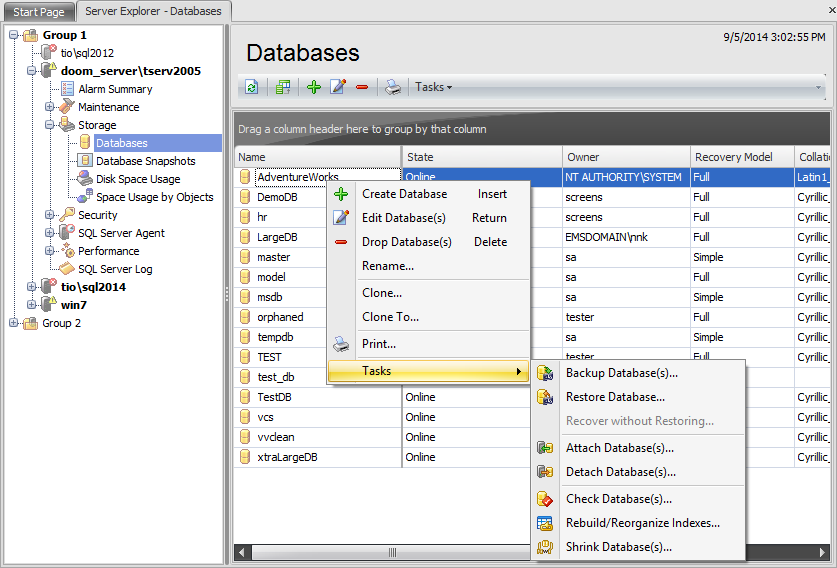Online Documentation for SQL Administrator for SQL Server
Databases
The Databases node of the Storage section is provided to manage the list of databases and perform common database tasks.
The toolbar and the context menu of the upper work area allow you to perform the following actions:
![]() create database
create database
![]() edit selected database(s)
edit selected database(s)
![]() drop selected database(s)
drop selected database(s)
- create the object copy on the same server
- clone the object copy to another server
- rename selected database
- perform the following tasks on the selected databases:
![]() create and print the report
create and print the report
Alternatively, you can use the 'Insert' button to create a database, 'Enter' button to edit database(s) and 'Delete' button to drop database(s).

The list displays databases as a grid with the following columns: Name, State, Owner, Recovery Model, Collation,
Compatibility Level, Creation Date. If necessary the following columns can be added: ANSI Null Default, ANSI Nulls, ANSI Padding, ANSI Warnings, Arithmetic Abort, Auto Close, Auto Create Statistics, Auto Shrink, Auto Update Statistics, Auto Update Statistics Asynchronously, Change Data Capture Enabled, Close Cursor on Commit, Concatenate Null Yields Null, Cross-Database Ownership Changing, Date Correlation Optimization, Default Local Cursor, Distributor, Encrypted, Encrypted Master Key, Forced Parameterization, Fulltext Enabled, In Standby Mode, Is Cleanly Shut Down, Merge Published, Numeric Round-Abort, Page Verify, Published, Quoted Identifiers, Read Committed Snapshot, Read-Only, Recursive Triggers, Reuse Log Space Waiting For, Service Broker Enabled, Service Broker GUID, Service Broker Priority Honored, Snapshot Isolation State, Subscribed, Synchronization with Backup, Trustworthy, User Access.
If more convenient, you can change the order of the columns by dragging their headers horizontally. See the Working with grid section of the SQL Administrator documentation to find out operations that can be performed with the grid.
To open a database in the Database Editor, double-click it in the grid. Alternatively, you can right-click the database alias and select the Edit Database context menu item.



































































